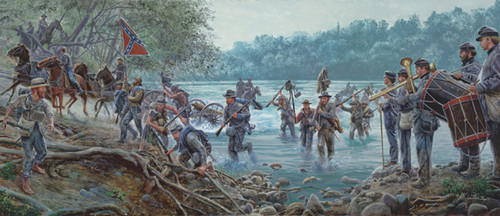Maryland, My Maryland by Mort Kunstler
NC 26th Potomac Crossing, June 25, 1863
Great North Carolina related Civil War painting.
In stock at Ashley's art Gallery
LIMITED EDITION PRINTS
Paper Prints
Reproduction technique: Fine offset lithography on neutral pH archival quality paper using the finest fade-resistant inks.
Each print is numbered and signed by the artist and accompanied by a Certificate of Authenticity.
Paper Signed and Numbered
Image Size: 13.25” x 31” • 18.25” x 35” • Edition Size: 750 • Issue Price: $225.00
Release Date: 2006
Giclée Canvas Prints
Reproduction technique: Giclées are printed with the finest archival pigmented inks on canvas.
Each print is numbered and signed by the artist and accompanied by a Certificate of Authenticity.
Canvas Signed and Numbered
Size: 16” x 37” • Edition Size: 100 • Issue Price: $575.00
Available at Ashley's Art Gallery
Release Date: 2006
Historical Information:
It was one of the war’s most dramatic moments – and the soldiers of Robert E Lee’s army knew it. They were crossing the Potomac River to take the war to the North. Less than a year earlier, Lee’s Army of Northern Virginia had tried to do so and had failed – their attempted invasion had been turned back at the battle of Antietam. Now, in the summer of 1863, Lee’s army was again wading the Potomac, crossing into Maryland, heading to Pennsylvania and Northern soil. This time they were fresh from a major victory at the battle of Chancellorsville and Lee hoped to win another victory in the North – one that would end the war’s awful bloodshed and gain Southern nationhood.
On the morning of Thursday, June 25th, the troops of General James J. Pettigrew’s Brigade – part of the Third Corps of Lee’s army – forded the Potomac near Shepherdstown, Virginia. Here, at Boteler’s Ford, the river was approximately 150 yards wide, marked in spots by scattered boulders, and was armpit-deep in places. Some men kept on their uniforms; while others stripped.
On the Maryland shore they shouted the “Rebel Yell,” and someone in the 26th N.C. began singing the lyrics of ”Maryland, My Maryland” – a poignant musical protest of the Northern occupation of Maryland. Other soldiers joined the chorus, and the poetic lament echoed over the broad river basin. An officer on General Pettigrew’s staff ordered the 26th North Carolina’s regimental band to play an accompaniment to the singing. The band – composed of accomplished musicians from the Moravian community in Salem, North Carolina – was renowned as one of the best bands in Confederate service. The musicians took up the tune and continued to play it until thousands of soldiers were across.
Just miles ahead across the Pennsylvania border lay the quiet crossroads hamlet of Gettysburg. There the great battle that Lee sought would be waged, but it would not end in Southern victory. Instead, it would prove to be the high water mark of the Confederacy and the beginning of the end of the Southern quest for independence. The North’s Army of the Potomac, defeated just weeks earlier, would prevail in defending Northern soil at Gettysburg, and untold thousands of Southern soldiers would not return across the Potomac.
Mort Künstler’s Comments:
Few events in the Civil War were more pivotal and dramatic than the 1863 Gettysburg Campaign. There are so many stories and so many scenes related to Gettysburg. Students of the war never tire of reading about them and I never get tired of painting them. One of the campaign’s most memorable and colorful events occurred when General Robert E. Lee’s Army of Northern Virginia crossed the Potomac on the Virginia–Maryland border. General A.P. Hill’s Third Corps, which was bringing up the rear of Lee’s army, forded the Potomac at Shepherdstown. I visited Shepherdstown in modern-day West Virginia, and went to the ford where the army crossed. Standing there today, it’s easy to imagine that remarkable scene. Such a colorful display of American fortitude and optimism! It gave me tremendous pleasure to research it and paint it.
General Pettigrew is seen in the upper left corner on horseback, accompanied by his staff, as he supervises the crossing. He will be promoted to division commander at Gettysburg, and will lead his troops almost all the way to the Federal line in the famous Pickett-Pettigrew Charge. Although wounded, he will survive the battle -– only to be killed in a minor skirmish during the return crossing.
The 26th North Carolina Infantry will distinguish itself at Gettysburg, and will record the highest casualty rate in a single battle of any regiment in the Civil War -- a staggering 85 percent. Mercifully, the 26th North Carolina band will survive intact after serving as stretcher-bearers in the battle. I have used the dark shapes of the band to frame the picture on the right and lead the viewer’s eye to the center of the painting and the excitement of this momentous event. The trees on the left also lead the eye back toward the crossing. The artillery teams are driven up the riverbank as the infantry scramble up from the water. This is one of the most unforgettable scenes of the Gettysburg Campaign, and painting it has been very meaningful for me.














